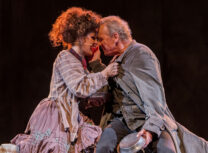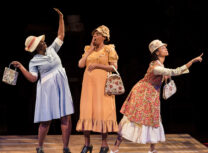Theatre of the Absurd & Buried Child

By A Noise Within
October 4, 2019
A father who doesn’t recognize his own son. Corn that grows overnight and out of nowhere. Visions of ancestors in a car windshield. The world of Sam Shepard’s Buried Child is riddled with nonsense, unreality, and bizarre events that spin the characters on their heads, with no end goal in sight – all of which is the definition of the Theatre of the Absurd. An artistic movement that began in the 50s and 60s, the Theatre of the Absurd explores and exaggerates the meaninglessness of human existence through meandering plots, illogical circumstances, and sharp dialogue.
Throughout Buried Child, Shepard follows a style similar to absurdist dramatists like Samuel Beckett, Eugène Ionesco, and Tom Stoppard – combining dreamlike, fantastical surrealism with comic absurdism. The most prevalent example is the crop of corn that the eldest son Tilden discovers in the backyard, despite the fact that his father Dodge hasn’t planted corn since 1935. The crop’s rapid growth does not make sense on a logical level, but on a surrealist level it reflects the family’s unconscious desire to express their darkest secret and untangle their collective trauma.
The absurdism intensifies when 22-year-old Vince returns to the family farm after being gone for 6 years – only to discover that Dodge and Tilden don’t recognize him as their grandson and son, respectively. Vince drives himself insane trying to prove his identity, but it does nothing to help. By revealing life as pointless and illogical, absurdists like Shepard shock the characters (and the audience) out of an existence that has become trite. Once that happens, we must confront the senselessness of our own lives and re-discover our identity in a world that provides no instruction manual.
Even though absurdist theatre emphasizes how confusing and disheartening life can be, the story does not end there. Martin Essin, who first coined the term “Theatre of the Absurd,” strikes an encouraging tone in his essay about absurdism:
It is a challenge to accept the human condition as it is, in all its mystery and absurdity, and to bear it with dignity, nobly, responsibly; precisely because there are no easy solutions to the mysteries of existence… The shedding of easy solutions, of comforting illusions, may be painful, but it leaves behind it a sense of freedom and relief. And that is why, in the last resort, the Theatre of the Absurd does not provoke tears of despair but the laughter of liberation.
Buried Child incorporates all that absurdist theatre has to offer and more – cleverly swinging from wicked humor to dramatic twists to an emotional cleansing that signals there is more to the dilapidated family farm than meets the eye.








